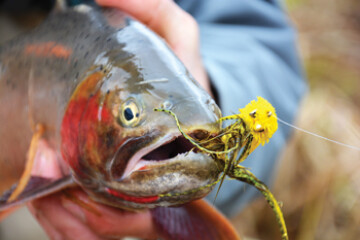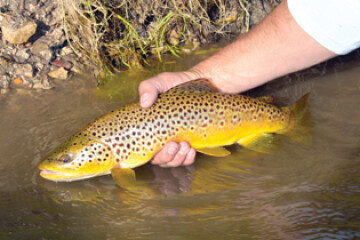Fishing Runoff in South West Montana
It’s inevitable, it’s a way of life, and it’s one of those things we have to deal with every spring. Runoff. But fear not, we are lucky enough to live in South West Montana where we have plenty of options to keep you on the water and catching fish all spring long. This year is shaping up to be a high-water year with snowpack upwards of 130% in some mountain ranges. While the peaks rid themselves of a winters worth of snow, the rivers will swell to their edges with dark turbulent waters making them all but unfishable. Below are a few pieces of water that will keep you busy through the worst of runoff.
Tailwaters:
The Madison River is a great option when the Gallatin and Yellowstone succumb to the muddy waters of spring. Both the Upper and Lower Madison are dam controlled making them much more fishable than our local freestone rivers. The biggest thing to look for when fishing the Madison is water flow stability. Like most tailwaters, the fish don’t like to feed after drastic changes in water flow. That means regardless of whether the flows are at 3,000 CFS or 1,500 CFS look for the flows to hold steady for two to three days before getting out on the water. On the Upper, large stoneflies and prince nymphs followed by a wire worm or egg pattern fished in front and behind boulders and in the tail outs of runs will produce fish.
On the Lower Madison, fishing tactics are significantly different. Using crayfish, rubberlegs, baetis nymphs, san juan worms, and egg patterns at this time of year will get you into fish but where and how you fish the Lower Madison is what makes its biggest distinction from the Upper section. Because the water coming from Ennis Lake is heated by the sun, it is significantly warmer and filled with weed beds, making trout hold in much different water than on the Upper. You will be looking for “buckets” or holes in the weed beds with gravel bottoms where fish will sit and wait for food to float by. A great way to learn where all of these buckets are located is by heading to the river when the water is off color and looking for brown spots in the green weed beds. The Lower stays relatively clean all spring, just keep an eye on Ennis Lake because when that body of water is stirred up by wind it will in turn dirty up the Lower.
The Missouri River is a legendary fishery known for producing above average Rainbow trout and fish numbers have been great over the past few years. With another high water year in the forecast this fishery is poised to produce another year of great fishing. Just like with the Lower Madison steady flows are key on this river. During spring the water flows exiting Holter Dam are raised and lowered to regulate water levels in Holter Reservoir. Look for flows to hold steady for two to three days before heading over to Craig. Proper rigging will be different with high water, lengthening your leader and upsizing your split shot to get your bugs near the bottom is key. Patterns will stay the same for the most part, fishing your san juans, scuds, pheasant tails, ray charles, and anything with a hot bead should find fish. At this time of year fish are looking to expend the least amount of energy while consuming the most calories as possible. Instead of holding in the faster seams and riffles, the fish will be inside of the seams in the soft slow water or at the tail-outs of islands. High-water doesn’t mean you can’t catch fish, you just have to change your tactics!
The Big Horn River is another fishery with a reputation for exceptional year round fishing. The water comes out of the deep and cold Big Horn Lake providing steady temperatures and excellent habitat for aquatic insects which translates to above average fish numbers. Mayflies, midge, scuds, and sow bugs are abundant but fishing can be little more technical than your average river. Lighter tackle and smaller flies are usually the norm out here. A Ray Charles and a Spanflex Worm are a great combo year-round.
Spring Creeks:
We are lucky to have three great spring creeks only a short drive away in Paradise Valley. Depueys, Armstrongs, and Nelson Spring Creeks stay clean all year and offer great fishing when the worst of runoff is in full swing. Get ready to test your technical fishing skills as these trout can be very picky. Light leaders and small indicators are the name of the game and your ability to maintain drag free drifts through the difficult currents will directly affect your success. During the Spring, the baetis hatches on these creeks will provide the best dry fly fishing around. If you don’t want to fish dry flies or the weather doesn’t permit, you can nymph these fish using baetis nymphs, San Juan worms, midge nymphs, and egg patterns. There may still be some rainbows spawning so keep an eye out for redds.
Local Lakes and Reservoirs:
Harrison Reservoir holds good numbers of Rainbows, Browns, and Brook trout. It is a crayfish factory which equates to fat, healthy fish. Fishing leech patterns, crayfish, and chronomidges off of points and drop offs for cruising trout is the best way to approach this lake and a float tube is very effective, just watch out for the wind picking up. Once the water warms up the lake is inundated with water skiers and wake boarders and isn’t worth dodging other watercraft after 11 am.
To the north of us, Canyon Ferry is a huge lake stretching 34 miles long and can be rather intimidating for the fly fisherman. One time of the year when fly fishing the lake is extremely productive is ice off, at this time rainbows will be cruising the edges of ice looking for leeches and small insects to feed on. Ice usually pulls off in the bays first and if you can find a bay with a creek inlet, you’ll be able to find some trout. Fishing wooly buggers are really tough to beat this time of year.
Hyalite Reservoir ices off later than most, once the road is reopened the fishing is usually in full swing. Focus your efforts on the far end of the reservoir where Hyalite Creek and Hood Creek flow in. Pay attention to the signs because these creeks don’t open until July 15th. Fishing leech patterns, wooly buggers midge nymphs, and prince nymphs will easily get you into fish.
Hopefully this will open your eyes to some of the different waters that we don’t normally think of fishing. We are lucky to have so much water in Southwest Montana, one should never feel out of options.

